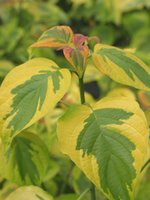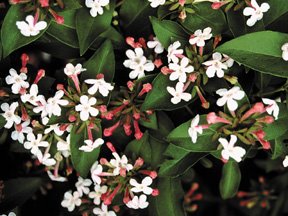
In the small coastal village of Varengeville-sur-Mer, in Normandy France, I had the pleasure of meeting the worlds foremost Hydrangea experts Robert and Corinne Mallet. Inside their small cottage, stacks of books, piles of herbarium specimens and a mass of photography towered about me and surrounded me. Everything within site, including the Mallets themselves, revolved around the genus Hydrangea. Call them advocates, fanatics or just plant crazy; they’ve devoted their lives to growing, studying and promoting Hydrangeas.
While I have other pursuits in my life, you might also call me a bit of a Hydrangea nut. After all - it was I who had traveled all the way to France to learn from the masters. Yes, Hydrangeas are a unique group of plants that can cast an inexplicable spell on those who grow them. To know the charm, beauty and usefulness of Hydrangeas is bound to create an enthusiast to some degree.
There are some 23 different species of Hydrangea. A few are evergreen, but most are deciduous forms of vines, shrubs or small trees. Where I live in Michigan, I can successfully cultivate about 10 different Hydrangea species. What is amazing is that only half of these species are readily available in the nursery trade and only five species of Hydrangea provide us with the hundreds of unique plants (cultivars) in which to beautify our gardens. While an unmentioned East Coast author (Martha Stewart) would espouse the beauty and bold brash colors of Hydrangea macrophylla (The Bigleaf Hydrangea), I would rather extol the virtues of some less glorious, but more reliable species. These Hydrangeas have proven themselves to be great garden plants for our harsh continental climate.
Climbing Hydrangea, Hydrangea anomala subsp. petiolaris (Eastern Asia, Zone 4 ) is a beautiful vine that climbs by aerial rootlets. It has glossy, heart heart-shaped leaves and white lacy blooms (corymbs) in early summer. It can be grown as a shrub, groundcover, or as a vine depending upon its culture. You have not lived until you have seen this plant in full bloom climbing up a tall oak tree. It is very happy on a north facing building or otherwise shady brick wall. I know of only a few cultivars, but most of them are hard to find in the market. 'Skylands Giant' is a selection with very large blooms. 'Tilifolia' is a selection with very small leaves, and ‘Fire Fly’ is good variegated selection with bold yellow and green leaves. All of these plants are worth hunting for and growing.
The Smooth Hydrangea, Hydrangea arborescens (Eastern U.S, Zone 3), is a wonderful, hardy plant that blooms in midsummer. It has the great advantage of blooming on the current seasons wood. This results in very reliable blooming regardless of frost or winter injury. The species is not a spectacular garden plant with its small mostly fertile flowers, but there are some noteworthy cultivars that are worth growing.
'Annabelle', introduce by Joe McDanials of Champaign, IL, is the most commonly grown cultivar. One is hard pressed to find any other cultivar of Hydrangea arborescens being sold today. There are some nurseries unknowingly selling the cultivars 'Grandiflora' as 'Annabelle'. True 'Annabelle' has very large, perfectly symmetrical blooms, while the blooms of 'Grandiflora' are often quartered and irregular. 'Annabelle' is very showy, but often collapses under the weight of its own blooms.
There is a need for more selections of H. arborescens. I would like to see an improved 'Annabelle' with sturdier stems. I also feel there is room for more lace-cap selections, especially selections made from plants like H. arborescens subsp. discolor which has light downy hair beneath the leaves and H. arborescens subsp. radiata which has snow white coloration on the underside of the leaves. I personally find these plants more graceful and delicate than 'Annabelle'.
There are three new introductions of H. arborescens on the market and both are very exciting. . Dutch horticulturist Wouter Kromhout brings us an exciting new lace-cap called White Dome This strong growing plant has extremely large dome-shaped blooms and large, attractive dark green leaves on a 5-6’ tall plant. This plant is exceptionally fine in the winter for its dried flowerheads look magical with a touch of frost or snow on them. (See image above). It can be mass planted to acheive the same winter interest you get with ornamental grasses like Miscantuhus.
Incrediball is a new and improved form of Annabelle with massive flowers and strong stems that hold up the blooms. This plant is larger in stature than Annabelle, reaching 4-4.5 feet tall.
Invincibelle 'Spirit' is the most exciting hydrangea introduction in years. It is the first pink flowerd form of 'Annabelle'. It was developed by Dr. Tom Ranney of NC State. Now we have the color of a Hydrangea macrophylla but with the dependability of H. arborescens. Very exciting!
Hydrangea arborescens is a very useful and adaptable plant. It grows in light shade or full sun, and once established it can be quite drought tolerant. Be careful not to over fertilize this plant or it will grow weak and leggy. I prefer to cut it back hard each spring to create a fuller bushier plant and to remove any winter damaged stems. In the landscape use it as a focal point for its white flowers can stand out from long distances. It also looks great in mass plantings.
The Panicle Hydrangea, Hydrangea paniculata (Asia, Zone 3) is a wonderful, hardy species that also blooms on new wood. It flowers in late summer to early fall. The cultivar Pee Gee or 'Grandiflora' is an old, commonly grown cultivar that deserves retirement. It has large floppy white panicles. Superior cultivars are now making their way to market. Most of these plants were developed by Robert and Jelena DeBelder of Belgium. 'Little lamb' is a DeBelder introduction with a dwarf compact habit. The flower heads are petit but full. They emerge a pure white and change to a rich pink in autumn. Pieter Zwijnenburg of Holland developed ‘Limelight’ a plant that is making quite the splash in the US. This incredible plant is noteworthy for several reasons. It sports attractive bright green flowers on strong upright stems. It blooms in early July, which is quite early for the species. ‘Limelight’ is at its best in autumn when the green flowers transform to breathtaking shades of green, pink and burgundy all on the same plant. I have seen numerous other selections of Hydrangea paniculata that are yet unnamed or introduced. We are currently evaluating a few selections but want to make certain that they are distinct and worthy before introduction. Also of note, the USDA has been attempting to cross H. paniculata and H. macrophylla in order to create a hardy, reliably blooming plant with interesting colors. Time will tell if this effort is successful.
Hydrangea paniculata is very easy to grow and adaptable to most garden soils so long as is it not planted in standing water. This plant makes a great blooming hedge if you don’t over prune it. Just let it grow and enjoy the color.
Hydrangea quercifolia (South Eastern U.S, Zone 5) know as the Oakleaf Hydrangea is a wonderful plant with distinct oak-like leaves. It has beautiful white panicles in midsummer that often fade to pink as they age. It is also noted for its blood red fall foliage color. The cultivar 'Snow Queen' is perhaps the standard by which all oakleaf cultivars are judged. It has large, upright panicles with large sepals and deep red fall color. 'Snowflake' is a beautiful, double flowered selection with large, pendulous panicles. The sepals age to purple even as new white sepals emerge to create a beautiful contrast. 'Harmony' has curious globular blooms. It is strictly a plant for collectors. Mike Dirr introduced a selection called 'Alice'. She has large panicles, good red fall color and extremely vigorous growth. Here too, we are evaluating other new selections that may warrant introduction.
Oakleaf Hydrangea is very reliable, easy to grow and thrives on neglect. It is extremely drought and heat tolerant. It will thrive in full sun or partial shade. It will flower in heavy shade but it will grow at a much slower rate. Use this plant in large mass plantings in commercial settings or as a specimen in a home landscape. Grow in contrast with plants with fine textures and narrow leaves. Please note that the wood on this plant is quite brittle, so it should not be planted where ice or snow could smash its structure.
As you can see, the genus Hydrangea is wonderfully diverse. But don't just take my word for it - the best way to know these plants is to grow them. But be careful, it’s fun and potentially addicting.
If you wish to learn more about Hydrangea I highly recommend the following books; Hydrangeas, Species & Cultivars a two volume set by Corinne Mallet, Hydrangeas, A Gardeners Guide, by Toni Lawson-Hall and Brian Rothera, and The Hydrangea by Michael Haworth-Booth. I also recommend joining the American Hydrangea Society, or if you're in Europe, the Shamrock Society.
















